
Dear Members:
For years I have watched my "snowbird" friends travel from frigid climates, in the dead of winter, to the warm weather of South Florida. They escape the cold weather and snowstorms in the northeast for two or three months of sun and warmth. This year, my wife, Pauline, and I decided to try it for ourselves.
Wow, did we pick the right winter to leave Boston. Multiple snowstorms, icy road conditions, and power outages were at record levels this year. In South Florida, the weather has been phenomenal with warm, sunny days and light breezes.
One bonus from this winter escape was having the opportunity to participate in BOB reunions in Florida, meet BOB members I've been communicating with by phone and e-mail for years, and to spend time with several BOB member friends who live, or spend their winters, in South Florida. Throw in a little golf, and it just doesn't get any better.
In this month's BOB Tales we talk about some of these reunions and review some of the information shared by Dr. Richard Hart, President of Loma Linda University Health "LLUH".
We also have much information to share about new studies showing the benefits of proton therapy for prostate cancer; the use of proton therapy for liver cancer metastasis; the key role sleep, and an important sleep hormone, play in preventing cancer; and new information on prostate cancer vaccines.
Our monthly brain teasers and humor section continue to stimulate considerable reader interest and response. Many admit these are the first sections they read. Several have sent along their personal favorites for inclusion in future newsletters. We encourage this.
The annual National Association for Proton Therapy "NAPT" conference will be held in Washington, DC, in late March/early April. I'll be there, as will representatives of all U.S. proton centers. The agenda is full.
Finally, the annual proton charity golf tournament is scheduled for April 28th at The Club at Morningside in Rancho Mirage, CA. I plan to rejoin my old team, and we have designs on winning the net this year. Anyone interested in participating in this fun event should contact Deb Hickey at [email protected].
Bob Marckini
As always, we invite feedback, constructive criticism, and suggestions for improving our newsletter. Just send an e-mail to Deb Hickey at [email protected] .
To print the BOB Tales newsletter or view the newsletter with a larger font size, click here for the PDF file.
in this issue
- Study shows IMRT affects bowel function more than proton therapy
- Proton therapy for prostate cancer: Long-term survival and quality of life report
- New hope for patients with metastases
- Prostate cancer vaccine: New developments
- Links between cancer and sleep
- New LLUMC infographic reveals efficacy and experience in proton therapy for cancer patients
- Member runs marathon during proton treatment
- Chemical in water bottle ups prostate cancer risk
- Link between sugar, heart disease, and death
- Important message for Medicare patients
- Quiz: Do you need to update your estate plan?
membership: 6,892

We added 83 new members last month. We have members from all US states and 35 countries representing all operating proton centers in the US as well as three proton centers in Europe and Asia.
news report
"IMRT had greater effect on bowel function than proton therapy."
That's the title of an article published last month in Healio–Hematology/Oncology, HemOnc Today. The article refers to a prospective study that compared 1,243 men who underwent proton therapy for prostate cancer to 204 men who were treated with IMRT. All patients in the study completed the Expanded Prostate Cancer Index Composite "EPIC" questionnaire to report their results.
According to the report, after two years most quality of life issues between the two groups were similar with the exception of bowel function, stating: "However, moderate or big problems with rectal urgency "P=.02" and bowel frequency "P=.05" were more common among men in the IMRT cohort." Further, "Although similar bowel, urinary and sexual scores were observed with IMRT and proton therapy, potential differences in specific functional outcomes, such as bleeding, rectal urgency and bowel frequency, also were observed and may reflect differences in radiation dose distributions between IMRT and proton therapy, differences in patient characteristics, or both."
Proton Therapy for Prostate Cancer: Long-Term Survival and Quality of Life Report
A five-year study, conducted by the University of Florida Proton Therapy Institute, reports 99 percent of men are living cancer-free and with excellent quality of life. The study was published in the International Journal of Radiation Oncology Biology, Physics.
The study followed 211 patients, all of whom received eight weeks of proton therapy. "Physician-reported data show cancer-free survival rates at five years for low-, intermediate-, and high-risk patients are 99 percent, 99 percent and 76 percent, respectively," according to the press release.
"These proton therapy results compare very favorably with IMRT results, particularly for intermediate risk-disease, where disease control rates of 70 percent to 85 percent are typical," according to Dr. Nancy Mendenhall, lead author and medical director of the UF Proton Therapy Institute.
Proton Therapy:
New Hope for Patients with Metastases
Results from a new Loma Linda University Medical Center "LLUMC" study reveal that proton therapy can successfully treat metastases to the liver and provide new hope for patients afflicted with advanced cancer.
Many types of cancer, including those of the head and neck, colon and rectum, breast, lung, esophagus, and pancreas, can spread to the liver. Since blood from all parts of the body must pass through the liver for filtration, cancer cells from other organs and tissues that reach the liver can lodge and grow into secondary tumors.

"Typically, invasive open surgery and chemotherapy have been the two main options for controlling liver metastases; but due to patients' immune systems being compromised or because they are weak, aged, and/or frail, many cannot withstand open surgery," says Gary Yang, M.D., professor of radiation medicine and head of the gastrointestinal service in the Department of Radiation Medicine at LLUMC.
It is estimated that two-thirds of patients with metastatic breast cancer eventually will present with spread to the liver. Of the more than 150,000 new cases of colorectal cancer that are predicted to occur in the United States this year, up to 50 percent of those patients are estimated to develop liver metastases.
The liver metastases study taking place at LLUMC is currently enrolling qualified patients. For more information, call 1-800-PROTONS "776-8667", or visit www.protons.com.
Prostate Cancer Treatment Vaccines:
New Developments
Early stage clinical trials are being planned for two potential vaccine treatments for prostate cancer. The vaccines are based on research at the University of Wisconsin"Madison Medical School. The research is focused on developing plasmid KDA vaccines to improve metastases-free survival and quality of life in men with prostate cancer.
The most promising vaccine targets prostatic acid phosphatase, a protein expressed by prostate cancer cells. This vaccine is currently in a Phase 2 clinical trial for patients with advanced localized cancer that has not yet metastasized, but is at high risk for doing so.
The objective for the first vaccine is to significantly delay the onset of metastases and the need to initiate androgen deprivation "hormonal" therapy for patients with aggressive disease.
The second vaccine, which is being designed to target the androgen receptor"which researchers believe stimulates prostate cancer growth"will be used to treat both early and later-stage disease.
Read more about these two vaccines.
Links Between Cancer and Sleep

Study Finds Poor Sleep Quality May Accelerate Cancer Growth
According to a new study, failing to get a good night's sleep can result in an acceleration of cancer growth.
The study was conducted with genetically engineered mice that were injected with tumor cells. Those with intentionally disturbed sleep experienced twice the growth rate of their cancers over a four-week period as those who were allowed to sleep normally.
According to study director, Dr. David Gozal "University of Chicago's Children's Hospital", poor sleep can significantly alter the immune system.
"It's not the tumor; it's the immune system. Fragmented sleep changes how the immune system deals with cancer in ways that make the disease more aggressive."
Sleep Hormone Linked to Lower Prostate Cancer Risk
A new study published in LiveScience shows that men with higher levels of the sleep hormone, melatonin, may be less likely to develop prostate cancer, and have a 75 percent decreased risk of advanced prostate cancer, compared to men with lower melatonin levels. The study was conducted on 930 men in Iceland between 2002 and 2009. The results were reported at the American Association for Cancer Research Conference on Advances in Prostate Cancer Research in San Diego in January.
The amount of sleep and the quality of sleep impact the amount of melatonin produced by the pineal gland in the brain. People who get less sleep, or whose sleep is interrupted, produce less melatonin.
Other studies have shown that melatonin levels influence cancer growth, and test-tube studies have shown that melatonin may even help slow or stop the growth of cancer cells.
Men in the study were not asked if they took melatonin dietary supplements, so there was no way to tell if there are any benefits from taking melatonin supplements.
The article suggests that, "Two of the best ways to preserve melatonin production are to keep a regular sleep schedule and to avoid light at night from sources like a television, computer screen, lamp or other types of indoor lighting."

New Infographic from LLUMC Reveals Efficacy and Experience in Proton Therapy for Cancer Patients
A new infographic highlighting the efficacy of proton therapy in successfully treating cancer and allowing people to return to a comfortable quality of life has been issued by LLUMC. The James M. Slater, M.D., Proton Treatment and Research Center at Loma Linda University Medical Center has treated more proton patients"more than 17,500"than any other facility in the world.
According to the infographic, since Loma Linda opened the world's first hospital-based proton therapy facility in 1990, the medical center has delivered more than 600,000 successful proton treatments to more than 240 different tumor sites. During that time the medical center has conducted more clinical trials on more tumor sites and published more long-term clinical outcome studies than any other proton facility in the world.
In addition, the new infographic confirms that Loma Linda is home to the world's most experienced clinical proton therapy team. Its physicians have, combined, more than 170 years of clinical proton therapy experience; its physicists/dosimetrists, more than 270 combined years; and its therapists, more than 350 combined years.
spotlight on members
Featured Member Interview: Gary Evans
Semiconductor Laser Researcher, Electrical Engineer, Teacher, Marathon Runner, Family Man
Born in Omak, Washington in 1948, Gary Evans teaches electrical engineering at Southern Methodist University in Dallas, Texas. He tells us he expects to continue teaching for the next five to ten years "if all goes well." If he's referring to his health, he's on the right track"literally; Gary, a vegetarian, runs every day; including having run 23 marathons since 2009. In fact, he ran the Fort Worth Cowtown "Fort Worth, TX" marathon today "at time of this writing,February 23, 2014"!
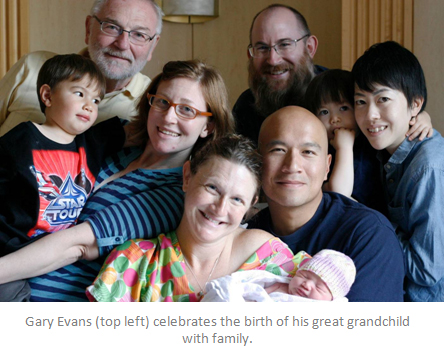
Fortunately for Gary, he had intimate knowledge of photons and protons before his prostate cancer diagnosis. This understanding came in handy when it was time to research treatment options.
Gary chose proton therapy because it gave him the best chance to continue living his life to the fullest. He chose Loma Linda University Medical Center because of their experience, their "Make Man Whole" motto, and their vegetarian menu.
Gary's wife of nearly 43 years, Judy Marie Kirk, passed away from complications of Parkinson's and Lewy Body Dementia in the summer of 2012. His mother passed away from brain cancer weeks later"just months before he began his treatment for prostate cancer.
Gary has three children and three grandchildren.
Deb Hickey: When were you diagnosed with prostate cancer?
Gary: My first biopsy, when my PSA was 6, was in April, 2011. The results were inconclusive, but there were some strange looking cells, and the urologist told me that he was sure I had prostate cancer. I waited another year before going to another urologist in April, 2012. By this time, my PSA was 7.38. I wasn't particularly alarmed or concerned with my diagnosis, in part because the previous urologist had already told me I had prostate cancer, and I was also in a bit of a fog because my wife and my mother both had severe medical issues. I had done a small amount of research on the Internet over the years, and it seemed that surgery was the default option. It also wasn't clear to me that the cure was better than the disease.
Deb: How did you learn about proton therapy?
Gary: A radiologist mentioned that MDA in Houston offered proton beam radiation. He also told me there was no evidence that proton is any better than regular radiation. I am embarrassed to say that statement didn't register with me at the time. He also mentioned radioactive seeds as an option, and recommended a Seattle doctor whose partner was someone I had co-authored several papers with on photodynamic treatment of cancer years earlier. My contribution to the papers was making the semiconductor lasers "that provide the photons" used in the treatment and I had only a sketchy understanding of the medical issues. I thought this was a good sign, but was disappointed when I was told that after the seed treatment the quality of my sex life "would be taken down a notch."
In early July, 2012, I got a phone call from a longtime friend and his wife. They knew several men who were pleased with the proton treatment they had received at Loma Linda University Medical Center in California, and they urged me to talk directly with these men.
Deb: Why did you ultimately choose proton treatment?
Gary: After the phone call from my friend, and before talking with the former proton patients, I immediately "finally!" realized that there was a huge difference between photon radiation and proton radiation. In making semiconductor devices, we often radiate semiconductors with particles such as protons, and many elements, such as arsenic and boron, to change the electrical characteristics in specific regions of the material. I have taught the physics of this process and I realized that this therapy was head and shoulders above my other choices. I talked with four people who had proton beam therapy and I read hundreds of stories on the "You Are Not Alone" website. I later found the BOB website. Talking to former patients and reading their stories pushed me in the right direction.
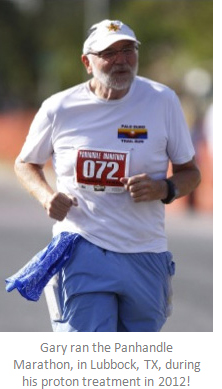
Deb: You live in Texas"why did you go to Loma Linda for treatment?
Gary: Primarily because of their experience. There were also a few other reasons: 1" My daughter and her family live in San Diego, so I could see them often, 2" I had friends and colleagues in the area, 3" I'm a vegetarian/vegan, and I knew that the cafeteria at LLUMC was vegetarian, and, 4" from my conversations with former patients, I learned about the incredible "Make Man Whole" concept and the extraordinary support network at Loma Linda.
Deb: Tell us about your treatment experience.
Gary: By the time I decided to have proton treatment in August, 2012, I was looking forward to ten weeks of solitude and reflection at Loma Linda. My wife had passed away in early June, and my mother, at age 92, had passed away in late June.
My time at LLUMC was everything I hoped for. Just like everyone says, the people there are amazing; everyone is helpful, caring, and kind. When my treatment was over, I wished I had another ten weeks there!
Deb: You ran a marathon while you were in treatment. Why did you decide to do this?
Gary: Well, my doctor at LLUMC told me, "Anything you were doing before treatment you can continue to do during treatment." I had run the Seattle marathon a few months earlier. The Lubbock marathon was coming up and I was interested in running it. When I learned it was on a Sunday, I figured I could fly out and back without missing a treatment. So, I did.
Deb: How are you doing now?
Gary: I feel good and my PSA is dropping.
These days, I try to play basketball, swim and/or lift weights a few times a week, in addition to running daily. Life is good.
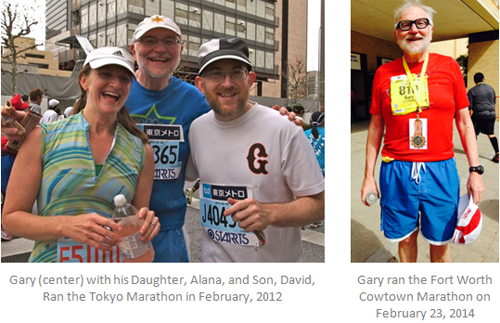
Member Feedback:
Bob received the following e-mail from member, Alan Leahigh
"Geneva, IL":
How frequently have you been complimented on your prostate?! In my annual physical last week, my internist remarked, during digital rectal examination, that my prostate felt remarkably normal in size and shape. He said that patients he sees who've had radiation therapy frequently have a shrunken gland. Whereas radiation kills prostate tissue, proton therapy kills the cancer.
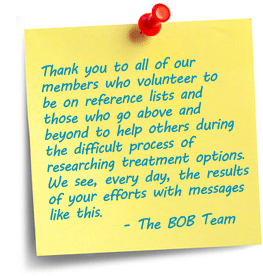
Deb received the following e-mail from a new member, currently in treatment:
I wanted to thank you both for the full list of contacts and the list of men with high Gleason scores. I contacted nine of them and they all talked to me for as long as I wanted. The BOB and its members are a wealth of information. I will begin my proton treatment program in February.
Feedback from Facebook Friends:
Here are a few recent comments on the BOB Facebook wall:
- I wait by the PC to download the BOB newsletter every month. Top notch reporting!
- Thank you, Brother BOB, for all that you do.
- Proton therapy saved my hubby's life … and his quality of life is fantastic!
- This world-class treatment is, thankfully, in our back yard. Thank you, Loma Linda!
Members Going Above and Beyond:
Drexel Hendon "Germantown, TN" doesn't miss a chance to spread the word about protons:
We did a Featured Member Story on Drexel Hendon in 2011. Drexel was treated with proton therapy for his prostate cancer in 2005. His sister, Wanda Kirkman, was also treated with proton therapy"for breast cancer. Both were treated at LLUMC and both are doing well today. They continue to support the treatment that saved both their lives.
One way Drexel spreads the word is by sending a link to the BOB Tales newsletter, each month, to friends and family. Each time, Drexel writes a personal note. His latest message reads:
Please review the Proton BOB Tales newsletter "link below". I received proton treatment for prostate cancer over eight years ago "2005" at Loma Linda University Medical Center. I join all those in this newsletter in their devotion to spread the word about proton beam radiation therapy for the treatment of their cancer"especially men with prostate cancer and women with breast cancer "other cancers, too".
My sister, Wanda Kirkman, contracted breast cancer 5 years ago, and based on my experience at Loma Linda, and my suggestion, she went there for her treatment following a lumpectomy at Vanderbilt Medical Center. We both had wonderful experiences/results and remain cancer free to this day.
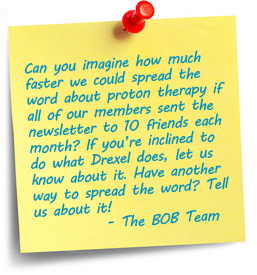
For a chat with either of us about our experiences, contact me via e-mail and/or go to the LLUMC website: www.protons.com.
P.S. Just recently, we buried a 65 year old gentleman, whom I communicated with, through a mutual friend, about three years ago when I gave him a copy of Bob Marckini's book "note the book's title in the newsletter" after he'd been diagnosed with prostate cancer. For whatever reason, he did not choose proton.
Please feel free to pass this information on"it saved my life!
Chuck Bloodgood "Salmon, ID" wrote to his local newspaper in order to "get the word out" about proton therapy. He sent the following message to Deb:
Just wanted to let you know that our town's weekly newspaper, The Recorder Herald, ran a 3/4 page article about proton treatment. It was a great article and I responded to it by giving my name and address. My response was printed in this week's paper!
The word is getting out. PRAISE GOD.
Here are some excerpts from Chuck's letter to the newspaper:
Everything that was said in the article [about proton therapy] is right on. In 2007, I had this procedure at Loma Linda University Medical Center in California where Dr. Slater, who developed this procedure, is practicing … Along with Dr. Slater's research, additional research is ongoing in the treatment of prostate cancer and other types of cancers including breast, head and neck, liver and lung … I am blessed to say that I have been cancer free now for six years … I would like to offer my assistance in explaining the proton procedure to anyone who may be looking for "the best way" to treat their cancer …
making a difference by giving back

Another Grateful Patient Gives Back
Lothar Ebbinghaus of Torrens Park, South Australia, recently donated $500 to the Robert J. Marckini Chair for proton research at Loma Linda. When we thanked him and asked how he's feeling, Lothar told us, "As of today, my PSA is .33. I am 75 years old and I can still swim, snow ski, practice yoga and I walk daily." Lothar also told us he watches his diet and feels like "a million dollars."
Matching Gift Promises to Double Yours
Don't forget: The founder of the Sequoia Foundation for Achievement in Culture and Education is encouraging fellow BOB members to match a $25,000 challenge grant. The foundation will match gifts of $1,000 or more to the Robert J. Marckini Chair, up to a total of $25,000, until December 31, 2014. Please consider taking this opportunity to double the impact of your gift!
If you are inspired to give or have questions about the various ways to support proton research efforts, please contact Aaron Laudenslager in the Office of Philanthropy at 909-558-3581 or [email protected].
You may also contribute by check. Just make your check out to "LLUMC Proton," specify Robert J. Marckini Chair in the memo, and mail it to: Loma Linda University Medical Center, Office of Philanthropy, P.O. Box 2000, Loma Linda, CA 92354.
Or, donate online. Specify Robert J. Marckini Chair under "Designations."
To learn about naming Loma Linda University Health in your will or trust, please contact the Office of Planned Giving at (909) 558-4553 or [email protected].
events
Recap: Florida Event
The last weekend of January, BOB members gathered together, with Loma Linda University of Health "LLUH" staff, for a fun-filled weekend of camaraderie and to attend a Loma Linda Comes to You meeting and BOB Reunion on Sunday.
On Saturday evening, BOB member, Chuck Kubicki, and his wife, Mary, hosted a dinner at The Ritz Carlton Club in Sarasota for eight BOB members and their spouses and friends.
Dr. Richard Hart, President of LLUH, Dr. Lynn Martell, DMin, Director of Special Services at LLUH, Rachelle Bussell, Sr. V.P. for Advancement at LLUH and Carolyn Hamilton, VP, Philanthropy, for LLUH were also in attendance.
Following the great food and fellowship, Chuck and Mary presented a $100,000 check for the Robert J. Marckini Chair for proton research! Chuck and Mary Kubicki have long been strong supporters of the BOB and proton research. Their several gifts in the past, including matching gifts, have provided much-needed funding for important proton research, such as the liver metastasis clinical study reported in this newsletter.
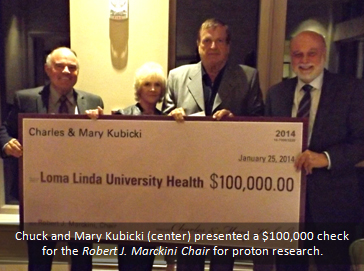
On Sunday, January 26th, Dr. Richard Hart hosted the Loma Linda Comes to You event, at the Florida Hospital conference center, with about 60 former proton patients from multiple treatment centers, and alumni of Loma Linda University. Dr. Hart presented a whole institution report on both the university and hospital front. After his presentation, Dr. Martell and Bob Marckini met with the proton group and the laughter was heard throughout the room.
On Monday, the 27th, BOB member, Pierre Rogers, and Lily Saenz hosted a reception in their lovely home followed by dinner at a nearby restaurant in Jupiter. It was a beautiful evening and a wonderful event attended by BOB members, spouses, friends, Bob and Pauline Marckini, and the LLUH team.

BOB members also gathered for lunch that afternoon in Fort Lauderdale. The entire weekend was fun-filled, memorable, and was shared by old friends and new. Thanks to all who attended!

Upcoming: NAPT 2014
When: March 31 – April 3, 2014
Where: Ritz-Carlton, Pentagon City, Washington, DC
Details: The National Association for Proton Therapy's second annual National Proton Conference is where proton community leaders and clinicians will meet to discuss "Advancing Cancer Treatment Access Worldwide." Click here to register.
health
You Might Not Want to
Take This Sitting Down
Lynn Thornstrom, abilities accommodation coordinator and ergonomics specialist for Loma Linda University Health, says sitting all day can be hazardous to your health. While she mentions there are several studies on this; she recommends a short book titled, Could You Stand to Lose, Weight Loss Secrets for Office Workers, by Mark E. Benden, PhD, CPE.
Benden, an associate professor of environmental and occupational health at Texas A&M University Health Science Center, says more than 400,000 people died in 2006 from obesity-related disease, the number two killer in the United States. Tobacco, which claimed 450,000 lives the same year, is ranked number one.
Several points are likely to raise eyebrows. For one, Benden asserts that while American consumers spend an average of $36 billion each year on diet supplements, books, and diets, there is no clinical evidence of long-term, sustained weight loss for even 1 percent of the population using exercise and diet alone. For another, he claims sedentary lifestyles are the reason members of the next generation of adults are predicted to be the first in history with shorter life expectancy than their parents.
Benden says too much sitting"whether in front of the computer at work or school, cruising the Internet, or watching TV"contributes to many deadly conditions including deep vein thrombosis, diabetes, and cardiovascular disease. He recommends workstations that allow people to either stand or sit, and advocates changing positions throughout the day.
His most encouraging assertion is that it's possible to lose an average of 20 pounds per year by standing 2.5 hours per day. To lose one pound of fat, a person could either:
- Walk 10 hours at a very fast pace;
- Bicycle at approximately 10 m.p.h. for 10 hours;
- Use a rowing machine for four to six hours;
- Work out on a StairMaster for six to eight hours, or;
- Stand 2.5 hours per day 10 days in a row.

Chemical in Water Bottle
Ups Prostate Cancer Risk
According to Gail S. Prins, PhD, professor of physiology, a material called bisphenol A, or BPA, commonly used in plastic water bottles and canned goods, has been linked to several diseases including prostate cancer.
Prins reported that BPA mimics estrogen, the female hormone, and is almost impossible to avoid since it is used in so many commercial applications. "We believe that BPA actually reprograms stem cells to be more sensitive to estrogen throughout life, leading to a life-long increased susceptibility to diseases including cancer," she observes.
According to the Center for Disease Control, BPA is also found in compact discs, impact-resistant safety equipment, and medical devices including those used in hospital settings. Recent studies also suggest that the public may be exposed to BPA by handling cash register receipts. The CDC offers these tips to avoid exposure:
- Don't microwave polycarbonate plastic food containers. Polycarbonate is strong and durable, but over time it may break down from repeated use at high temperatures.
- Avoid plastic containers with the #7 on the bottom "what the numbers mean".
- Don't wash polycarbonate plastic containers in the dishwasher with harsh detergents.
- Reduce your use of canned foods. Eat fresh or frozen foods.
- When possible, opt for glass, porcelain, or stainless steel containers, particularly for hot food or liquids.
- Use infant formula bottles that are BPA free and look for toys that are labeled BPA free.
The Not-So-Sweet Link Between
Sugar, Heart Disease, and Death

An article published in the February 3, 2014, online edition of JAMA Internal Medicine reports that researchers from the Centers for Disease Control and Emory and Harvard universities recently found that high sugar intake is linked to risk factors for cardiovascular disease, also known as CVD, and mortality.
The article notes that most adults in the United States consume more added sugar than is recommended for a healthy diet, and adds that there is a "significant relationship" between added sugar consumption and increased risk of CVD mortality.
It also found a significant increase in the amount of added sugar consumed between two studied periods: 1977-1978 and 1994-1996. During that time, the number of added sugars consumed by Americans above the age of 2 rose, on a daily basis, by 83 calories. Multiply that number by 365 days per year, and the average American's sugar consumption during that period increased by 30,295 calories per year. That translates to enough extra sugar to pack on an extra 8.65 pounds on every person per year.
The study concludes that the difference in sugar consumption between the two test periods is largely attributable to the increased use of sugar-sweetened beverages. The authors point out that earlier research"randomized clinical trials and epidemiologic studies"found that individuals who consume higher amounts of added sugar, especially those who drink sugar-sweetened beverages, tend to not only gain more weight, but also have higher risk factors for obesity, type 2 diabetes mellitus, dyslipidemias, hypertension, and CVD.
Bottom line: Lay off the sodas and eat fruits, nuts, whole grains, and vegetables instead of processed sugar-laden foods if you want to live healthier and postpone mortality.
Bob's book
Amazon.com: 180 Reader Reviews
The book has received 10 more Amazon reviews since last month! Here is a recent review:

Must-read Resource! "Kathy
This is an excellent and thoroughly-researched analysis of the various treatments of prostate cancer at the time the book was written. The author chose proton therapy at the conclusion of his research and is one of its biggest advocates. My husband is a very logical thinker"an engineer like Mr. Marckini"and his research ended with the same conclusion and the same life-extending treatment. We are so grateful to Mr. Marckini for cataloging his research in such a readable way that even I could understand! Highly recommended; we give it away when we learn of someone who is newly diagnosed with prostate cancer.
Did you find Bob's book helpful?
Please help us to spread the word and educate others about proton therapy. If you found Bob's book to be helpful in making your proton treatment decision, please post a review on Amazon.
Once you are logged into your Amazon account, click here and click the "Create your own review" button. NOTE: Reviews can be just a few sentences"it only takes a few minutes. And, don't forget to rate the book from 1 to 5 stars!
Don't have an Amazon account? No problem. Sign up here"it's free.
Available in Amazon's Kindle format, Barnes & Noble's NOOK Book, and Apple iBook format
Buy the Kindle version now for $9.99.
Don't have a Kindle? No problem"just download the free Kindle reading software for your smart phone or tablet.
Buy the NOOK Book version now for $9.99.
Don’t have a NOOK? No problem. Just download the free NOOK reading app for your Android smart phone, tablet, or iDevice.
Buy the book from the iTunes store for $9.99 for your iPhone, iPad, or iPod Touch in iBook format.
The hard copy version of You Can Beat Prostate Cancer is available online at Amazon, Barnes & Noble and LuLu Press.
Proceeds from book sales are used to help fund BOB efforts and to support proton therapy research.
Ask about our bulk discount for hard copy books for anyone interested in spreading the word about proton therapy: [email protected]
odds & ends
Medicare Patients Take Notice
According to a recent report on NBC Nightly News, if you are admitted to the hospital and the words on the form say, "Under Observation," you may find you are liable for thousands of dollars in payments. Instead, request that you are admitted with an "In-Patient" designation. One patient in the story broke her leg and was admitted to the hospital for rehabilitation. Her bills came to $28,000. She was told it was not covered by insurance and she had to pay out-of-pocket. Last year, more than 600,000 patients found themselves in the same quandary.
Bottom line: If you are a Medicare patient and are being admitted to the hospital, according to the NBC segment, you should challenge the words "Under Observation," and request instead, the words, "In-Patient" to avoid this problem.
Do You Need to Update Your Estate Plan? Take This Quiz.
Have there been significant changes in your life recently? If so, let this short quiz help identify whether you need to review your estate plan.
Since last updating your estate plan, have you:
- Added new members to your family such as children, grandchildren, adopted children or other new heirs?
- Moved to a different state?
- Sold or purchased any major assets or property?
- Reached the age of 70½?
- Lost a selected beneficiary for any reason?
- Gotten divorced or remarried?
- Experienced a change in the value of your estate?
- Added a major property to a living trust?
- Lost a selected executor or trustee for any reason?
- Waited three years or more to review your estate plan?
If you answered "Yes" to any of these questions, you may need to review your estate plan to make sure it still represents the legacy you wish to leave behind.
Special Series:
Did You Know THIS About Your Body?
The human body is a treasure trove of mysteries, one that still confounds doctors and scientists about the details of its working. It's not an overstatement to say that every part of your body is a miracle. Last month, we gave you five interesting facts about your body. Below are five more"again, most will surprise you.
 |
The fastest growing nail is on the middle finger. |
 |
Facial hair grows faster than any other hair on the body. This is true for men as well as women. |
 |
There are as many hairs per square inch on your body as a chimpanzee. |
 |
A human fetus acquires fingerprints at the age of three months. |
 |
By the age of 60, most people will have lost about half their taste buds. |
Next month, we'll post five more interesting facts about the human body and continue doing so for the next four months.
on the lighter side
Last Month's Brain Teaser: Weigh This Fish
What is the weight of a fish if it weighs 10 pounds, plus half its weight?

This one is easy for anyone who knows simple algebra.
Answer:
The fish weighs 20 pounds.
How did we arrive at this answer?
Using simple algebra, let W = weight of the fish.
"A fish weighs 10 pounds plus half its weight" translates into W = 10 + ½ W
Solving for W, W – ½ W = 10, so, W/2 = 10, and W = 20
And testing the answer: 10 plus half of 20 = 20.

Bob Roos of Templeton, California, was the first to submit the correct answer to last month's brain teaser.
One of the reasons we love profiling our brain teaser winners is because they are so interesting. Bob refers to himself as a "gentleman farmer" raising olives and making award winning olive oil at his family's Homestead Olive Ranch, a small farm in California's San Luis Obispo County.
Bob told us, "I am doing great. My last PSA was 0.22." Bob was a retired power plant operator at the time of his proton treatment in the summer of 2012. Back in January of that year, his doctor told him that his PSA was rising and that he should see a urologist. The urologist informed Bob about all treatment options, including proton treatment, but his recommendation was surgery.
"It was my daughter, a nurse practitioner, who gave me Bob's book," Bob said. "She got it from a patient of hers." Bob was thankful he later had the opportunity to thank Bob Marckini personally while at a Wednesday night meeting at Loma Linda.
Congratulations, Bob! Your signed book is on the way.

New Brain Teaser: Man and the Elevator
A man lives in an apartment building on the 12th floor. Every day when he goes home from work, he takes the elevator up to the 8th floor, and then takes the stairs the remaining 4 floors. The elevator is fully functioning and he does not do this for exercise.
Why does he do this?
Answer next month: The first to send an e-mail to [email protected] with the correct answer will receive a signed copy of Bob's book. No cheating by using the Internet!
Cranky Shoplifter
A very cranky old woman was arrested for shoplifting at a grocery store. She gave everyone a hard time; from the store manager to the security guard to the arresting officer who took her away; she complained and criticized throughout the process.
When she appeared before the judge, the judge asked what she had stolen from the store. The lady defiantly replied, "Just a stupid can of peaches."
The judge then asked why she had done it. She replied, "I was hungry and forgot to bring any cash to the store."
The judge asked how many peaches were in the can. She replied, "Nine, but what do you care about that?"
The judge patiently said, "Well, ma'am, because I'm going to give you nine days in jail"one day for each peach." As the judge was about to drop the gavel, the lady's long suffering husband raised his hand and asked if he might speak.
The judge said, "Yes, what do you have to add?"
The husband said, "Your Honor, she also stole a can of peas."
Grocery Shopping Husband
A wife asks her husband, "Could you please go shopping for me and buy one carton of milk and if they have avocados, get six."
A short time later the husband comes back with six cartons of milk.

The wife asks him, "Why did you buy six cartons of milk?"
He replied, "They had avocados."
If you're a woman, I'm sure you're going back to read it again!
Men will get it the first time.
Quote of the Month
"Good friends are like quilts"they age with you, yet never lose their warmth."
"Unknown
final thought

Some people are old at 18 … and some are young at 90 …
Time is a concept that humans created.
Low PSAs to all,
Bob Marckini and Deb Hickey
You can download this month's BOB Tales in PDF format to your computer by "right-clicking" ("control-clicking" on Mac) and going to the "Save Target As… " option on the menu that pops up.
NO MEDICAL ADVICE: Material appearing here represents opinions offered by non-medically-trained laypersons. Comments shown here should NEVER be interpreted as specific medical advice and must be used only as background information when consulting with a qualified medical professional.

